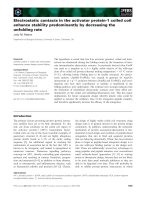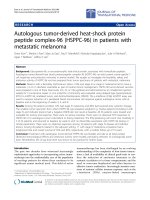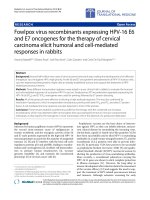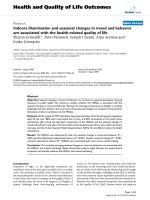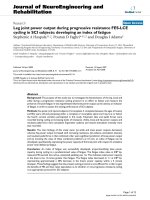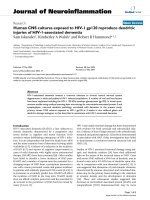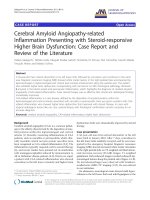Báo cáo hóa học: " Epstein-Barr virus encoded latent membrane protein 1 regulates mTOR signaling pathway genes which predict poor prognosis of nasopharyngeal carcinom" pot
Bạn đang xem bản rút gọn của tài liệu. Xem và tải ngay bản đầy đủ của tài liệu tại đây (947.19 KB, 9 trang )
Chen et al. Journal of Translational Medicine 2010, 8:30
/>Open Access
RESEARCH
BioMed Central
© 2010 Chen et al; licensee BioMed Central Ltd. This is an Open Access article distributed under the terms of the Creative Commons
Attribution License ( which permits unrestricted use, distribution, and reproduction in
any medium, provided the original work is properly cited.
Research
Epstein-Barr virus encoded latent membrane
protein 1 regulates mTOR signaling pathway genes
which predict poor prognosis of nasopharyngeal
carcinoma
Jing Chen
1,2,3
, Chun-Fang Hu
4
, Jing-Hui Hou
1,2
, Qiong Shao
1,2
, Li-Xu Yan
1,2
, Xiao-Feng Zhu
1,5
, Yi-Xin Zeng
1,5
and Jian-
Yong Shao*
1,2,5
Abstract
Background: The oncoprotein Epstain-Barr Virus (EBV)-encoded latent membrane protein1 (LMP1) modulates the
pathological effects of the NF-κB, AP-1 and JAK/STAT pathways in nasopharyngeal carcinoma (NPC).
Methods: Microarray analysis was performed on the NPC cell line HONE1 stably transfected with a LMP1-expression
plasmid or an empty vector. Based on assigned pathways analyzed using the KEGG database, the mTOR signaling
pathway was selected for verification by quantitative RT-PCR. Western blot, RNA interference and immunofluorescence
were used to determine the relationship between LMP1 and mTOR signing pathway genes, and their clinical
significance to NPC.
Results: Our studies revealed that overexpression of LMP1 upregulated the mTOR signaling pathway, possibly through
phosphorylation of AKT/mTOR/P70S6K/4EBP1 in the NPC cell lines HONE1 and 6-10B. Knockdown of LMP1 reduced
expression of p-mTOR and p-4EBP1 in EBV-positive NPC cell line C666-1. In addition, LMP1 expression closely correlated
with expression of p-mTOR, p-P70S6K and p-4EBP1 in NPC tumors. Expression of p-P70S6K, p-4EBP1 and LMP1, but not
p-mTOR, significantly correlated with overall survival of NPC patients. However, only LMP1 was an independent
prognostic factor.
Conclusions: These results suggest that the mTOR signaling pathway is regulated by LMP1 expression in NPC. LMP1
and the genes in the mTOR pathway such as p-P70S6K and p-4EBP1 may be potential prognostic biomarkers.
Background
Nasopharyngeal carcinoma (NPC) is a unique cancer of
the head and neck that has a high incidence in Southern
China, where it is endemic, at 25 cases per 100,000 per-
son-years in the Guangzhou area [1]. Most NPC patients
can be cured if the disease is diagnosed and treated at an
early stage. However, the long-term survival rate of NPC
patients with advanced stage cancer is still very poor, with
a median survival time for patients with distant metasta-
sis of only 9 months [2].
Epstein-Barr virus (EBV) is a human herpesvirus that
has been intimately associated with both lymphoid and
epithelial malignancies including lymphoma, NPC and
gastric cancer [3]. NPC tumor cells express a limited set
of EBV latent genes including EBV nuclear antigen 1,
latent membrane proteins (LMP1, LMP2A, LMP2B), and
EBV-encoded small RNA [4]. Of these genes, LMP1 has
been identified as encoding an oncoprotein that is
thought to be a key modulator in NPC pathogenesis. In
NPC, LMP1 contributes to invasion and metastasis by
inducing expression of matrix metalloproteinase 9
(MMP9)[5]. In addition, LMP1 may mediate various
pathological effects such as promotion of cell prolifera-
tion, metastasis and inhibition of apoptosis in NPC [6].
As a member of the tumor necrosis factor receptor super-
* Correspondence:
1
State Key Laboratory of Oncology in Southern China, Sun Yat-Sen University
Cancer Center, Guangzhou, China
Full list of author information is available at the end of the article
Chen et al. Journal of Translational Medicine 2010, 8:30
/>Page 2 of 9
family, LMP1 expression can activate the nuclear factor-
kappa B (NF-κB), activator protein 1 (AP-1) and employ-
ing Janus kinases (JAKs) or and signal transducers and
activators of transcription (STATs) (JAK/STAT) pathways
and regulate their substrates[6]. LMP1 also targets the
phosphatidylinositol-3-kinase (PI3K)/AKT pathway to
induce fibroblast transformation and enhance cell sur-
vival [7,8]. Moreover, LMP1 can promote epithelial cell
motility and enhance invasiveness by activating the extra-
celluar signal-regulated kinase/mitogen-activated protein
kinase (ERK-MAPK) pathway [9].
Mammalian target of rapamacin (mTOR) is an evolu-
tionarily conserved serine/threonine protein kinase with
an important role in cell growth and proliferation
through regulation of ribosome biogenesis and protein
translation [10]. PI3K/AKT is considered a critical
upstream mediator of the mTOR signaling pathway. The
characterized downstream effectors of mTOR are ribo-
somal protein S6 kinases (P70S6K), and eukaryotic initia-
tion factor 4E (eIF4E)-binding protein (4E-BP1), with
eIF4E dissociating from 4E-BP1 to initiate translation
after 4E-BP1 phosphaorylation, while P70S6K translates
mRNA transcripts with a 5'-TOP motif following hyper-
phosphorylation by mTOR [11,12].
To further clarify the signaling pathways regulated by
LMP1 in NPC, we investigated the association between
the mTOR signaling pathway and LMP1, the expression
of p-mTOR, p-P70S6K and p-4EBP1, and their relation-
ship to clinicopathologic parameters of NPC patients.
Materials and methods
Patients and tissue samples
For this retrospective study, archival formalin-fixed, par-
affin-embedded specimens from 230 primary NPC
patients admitted from 1992-2002 to the Sun Yat-Sen
University Cancer Center (Guangzhou, China) were
recruited. All NPC samples were obtained before treat-
ment with standard curative radiotherapy, with or with-
out chemotherapy. Sixty patients were diagnosed as
differentiated non-keratinized (WHO types II), and 170
patients had undifferentiated carcinoma (WHO type III).
According to the Chinese 1992 staging system [13],
patients were classified as 6 in stage I, 49 in stage II, 110
in stage III, 65 in stage IV. The majority of patients were
male (173 of 230, or 75.2%), ranging from 86 to 14, with a
median age of 46. This study was approved by the
Research Ethics Committee of the Sun Yat-Sen University
Cancer Center (Reference number: YP2009167).
Tissue microarray construction
Paraffin-embedded specimens were from a previously
constructed tissue microarray. Protocols and instruments
for the tissue array construction were described previ-
ously [14].
Immunohistochemistry
The immunohistochemistry (IHC) protocol was as
described previously [14]. Briefly, tissue sections were de-
waxed for antigen retrieval, and incubated with primary
antibodies LMP1 monoclonal antibody (CS 1-4, Neo-
markers, USA) at a dilution of 1:50, or p-mTOR
(Ser2448), p-P70S6K (Thr389), or p-4EBP1 (Thr70) (Cell
Signaling, USA) at dilutions of 1:100 overnight at 4°C.
Detection was with a Catalyzed Signal Amplification Kit
(DAKO Co, Carpinteria, USA) and visualization was with
3, 3'-diaminobenzidine (DAB).
IHC results were evaluated and scored independently
by two pathologists without knowledge of patient clinico-
pathological outcomes. IHC expression levels for LMP1,
p-mTOR, p-P70S6K and p-4EBP1 were assessed by a
semi-quantitative scoring system according to the inten-
sity of staining and percentage of tumor cells stained.
Staining intensity was scored as 0 = negative, 1 = weak, 2
= moderate, 3 = strong. The percentage of tumor cells
stained was scored as 0 = no tumor cells stained, 1 = 1-
10% of tumor cells stained, 2 = 11-50% of tumor cells
stained, 3 = 51-100% of tumor cells stained. The two indi-
vidual parameters were added, resulting in an immunore-
activity score (IRS) ranging from 0 to 6. We defined cases
with IRS ≥ 4 as high expression, and cases with IRS < 4 as
low expression.
Cell culture and plasmids
The EBV-negative human NPC cell lines HONE1 and 6-
10B, and the EBV-positive NPC cell line C666-1 were
incubated in RPMI-1640 medium supplemented with
10% fetal bovine serum (FBS) (Gibco, USA), 100 units of
penicillin/ml and 100 μg of streptomycin/ml. All cells
were maintained in a humidified incubator at 37°C with
5% CO
2
.
The eukaryotic expression plasmid pZipNeoSV-LMP1
containing the B95.8-LMP1 gene was kindly provided by
Professor Kai-Tai Yao from Nan Fang Medical University
(Guangzhou, China) [15].
Transient and stable transfection
Briefly, 4 × 10
5
cells per well were plated into six-well
plates and grown for one day in antibiotic-free medium
containing 10% FBS prior to transfection. Plasmid pZip-
NeoSV-LMP1 and control vector transfection were per-
formed with Lipofectamine 2000 (Invitrogen, CA)
according to the manufacturer's instructions. Further
assays were conducted after 48 h incubation of transiently
transfected cells.
To generate the stable transfected cell lines HONE1-
LMP1 and HONE1-vector, cells were passaged at 1:6 into
fresh growth medium 24 h after transfection. G418
(Amresco, USA) at a final concentration of 150 μg/ml was
Che n et al. Journal of Translational Medicine 2010, 8:30
/>Page 3 of 9
added to complete medium to select resistant cells.
Clones were separated and expanded into stable cell lines.
Western blot analysis
Transfected cells were harvested and lysed with RIPA
buffer (Upstate, USA). Denatured proteins were sepa-
rated by SDS-PAGE electrophoresis and transferred to
PVDF membranes (Roche, Germany), and incubated
with primary antibodies LMP1 (BD, USA), p-IκBα, phos-
phatase and tensin homolog (PTEN), Poly ADP-ribose
polymerase (PARP), Survivin, AKT1, p-AKT (Thr308)
(Santa Cruz, USA), mTOR, p-mTOR(Ser2448), p-
P70S6K(Thr389), p-4EBP1 (Thr70) (cell signaling, USA)
and p-NF-κB p65 (Ser276) (Kangchen, China) overnight
at 4°C in 5% skimmed milk/TBST (Tris-buffered saline
solution containing 0.1% Tween 20) at a dilution of
1:1000. GAPDH (1:3000 dilution, Santa Cruz, USA) was
used as internal control. Horseradish peroxidase-conju-
gated second antibody incubation was followed by
chemiluminescence detection with an ECL Western blot
Kit (Cell Signaling Technology, USA). Densitometry to
quantify proteins was conducted by Image J 1.37 v soft-
ware (NIH, USA).
RNA extraction
Total RNA was isolated by Trizol (Invitrogen, CA) and
purified by Nucleospin RNA clean-up (MN, USA). All
procedures were performed according to the manufac-
turer's instructions. Formaldehyde agarose gel electro-
phoresis was carried out to quantify the total RNA.
cDNA microarray analysis
The human 22 K oligonucleotide microarray comprised
21,329 probes from the Operon Company (Human
Genome Oligo Set Version 2.1), constructed by Capitol-
Bio Corporation (Beijing, China). Hybridization to each
array was performed with equivalent amounts of
HONE1-LMP1 and control HONE1-vector samples that
were differentially fluorescence-labeled with Cy3 or Cy5.
Fluorescence exchange experiments were performed.
Hybridization and image capture were as previously
described [16]. Normalization was based on a LOWESS
program [17]. All original data was submitted to the Gene
Expression Omnibus />ects/geo/ with the accession number GSM467646. Genes
with signal intensity (Cy3 or Cy5) > 800 were regarded as
expressed, and alteration ratios above 1.3-fold, or lower
than 0.7, were defined as differential expression. Path-
ways analysis of all differentially expressed genes was per-
formed according to the Kyoto Encyclopedia of Genes
and Genomes (KEGG) database.
Quantitative real-time PCR (Q-RT-PCR)
To validate the microarray results, five genes associated
with the mTOR signaling pathway were analyzed by Q-
RT-PCR. Primers were designed by Primer 5.0 (Addi-
tional file 1). Following the manufacturer's protocols,
cDNA was prepared from 2 μg total RNA by M-MLV
reverse transcriptase (Promega, USA) and amplified with
a DNA Master SYBR Green I Kit (Roche, Germany). The
relative expression ratio was determined by the formula
2
-ΔΔCt
(ΔΔCt = ΔCt
HONE1-LMP1
-ΔCt
HONE1-Vector
, ΔCt =
Ct
gene
-Ct
GAPDH
, where Ct is the cycle number at which
the fluorescence signal exceeds background) [18].
Small interfering RNA (siRNA) transfection
The LMP1 and negative control siRNA were chemically
synthesized by GenePharma Corporation (Shanghai,
China). The sequences of LMP1 siRNA (EU000388,
miRNA nucleotide 371-389) were: sense sequence, 5'-
GGA AUU UGC ACG GAC AGG CTT-3'; anti-sense
sequence, 5'-GCC UGU CCG UGC AAA UUC CTT-3'
[19,20]. The sequences of negative control siRNA were:
sense sequence, 5'-UUC UCC GAA CGU GUC ACG
UTT-3'; anti-sense sequence, 5'-ACG UGA CAC GUU
CGG AGA ATT-3'. The EBV-positive NPC cell line
C666-1 was seeded in a 24-well plate with 4×10
4
cells per
well in growth medium without antibiotics the day before
transfection. Following the manufacturer's instruction, 1
μl Lipofectamine2000 was used in each well with final
siRNA concentration at 50 nM or 100 nM.
Immunofluorescence assay
After 72 h of siRNA transfection, cells were harvested
and washed thrice with PBS, suspended in PBS and cen-
trifuged on the slides. Slides were fixed with 4% para-
formaldehyde for 30 min, permeabilized, and cells
covered with 0.1% Triton X-100 for 15 min. After 1 h
blocking in PBS + 0.1% Tween plus 1% bovine serum
albumin, cells were incubated with primary antibodies of
LMP1 (BD, USA), p-mTOR (Ser2448) and p-4EBP1
(Thr70) (Cell Signaling, USA) at 4°C overnight, then with
secondary antibody for 1 h at room temperature. After
counterstaining with DAPI (1 μg/ml) for 10 min, slides
were observed and photographed with confocal micros-
copy.
Statistical analysis
Data was analyzed using SPSS16.0 software (SPSS Inc.,
Chicago, USA). The correlation between LMP1, p-
mTOR, p-P70S6K, p-4EBP1 expression and clinicopatho-
logical parameters was assessed by chi-square test. The
correlation between LMP1 and p-mTOR, p-P70S6K, p-
4EBP1 expression was measured by Spearman's correla-
tion test. Kaplan-Meier analysis and log-rank test were
used to assess survival rate and compare survival rate dif-
ferences. Univariate and multivariate regression analysis
were performed with the Cox proportional hazards
regression model to analyze the factors related to progno-
sis. A p-value less than 0.05 was considered statistically
significant.
Chen et al. Journal of Translational Medicine 2010, 8:30
/>Page 4 of 9
Results
Microarray analysis of differentially expressed genes in
HONE1-LMP1 cell line
As shown in Figure 1, the HONE1 cell line stably trans-
fected with the B95.8-LMP1 plasmid showed up-regula-
tion of NF-κB pathway downstream genes p-IκBα and p-
NF-κB (2.5-fold), and PARP and survivin (1.4-fold), while
down-regulation of PTEN was observed (0.5-fold).
A total of 1533 genes were differentially expressed
(1034 up-regulated genes and 499 down-regulated genes)
in the HONE1-LMP1-transfected cells compared to
those transfected with the control HONE1-Vector. Using
the KEGG database, we determined that these genes clus-
tered in several signaling pathways, including the insulin,
MAPK, Wnt, TGF-beta, Notch and mTOR signaling
pathways, and apoptosis. Five of the differentially
expressed genes involved in the mTOR signaling pathway
were validated by Q-RT-PCR (Figure 2).
LMP1-regulated genes in mTOR signaling in NPC cell lines
LMP1 expression increased by 2.9-fold in HONE1 cells
stably transfected with pZipNeoSV-LMP1, as measured
by immunoblot. The p-AKT and p-mTOR genes,
upstream in the mTOR signal pathway, were upregulated
in 1.6-fold and 1.9-fold, respectively. The downstream
genes p-P70S6K and p-4EBP1 were also upregulated, by
1.5-fold and 1.3-fold, respectively. When LMP1 was tran-
siently transfected into the NPC cell line 6-10B, up-regu-
lation of p-AKT was 1.3-fold, p-mTOR was 1.5-fold, p-
P70S6K was 1.2-fold, and p-4EBP1 was 1.4-fold, consis-
tent with results from the HONE1-LMP1 cell line (Figure
3). Immunofluorescence in the EBV-positive NPC cell
line C666-1 revealed that after LMP1 knockdown with
siRNA at 50 nm or 100 nm, LMP1, p-mTOR and p-4EBP1
were significantly deregulated compared to the C666-1-
NC-siRNA cell line (Figure 4).
Correlation of expression of LMP1, mTOR signaling
pathway genes and clinicopathology of NPC patients
Representative IHC staining and hematoxylin-eosin
(H&E) staining of NPC tumour is shown in Figure 5. In
NPC tissue with LMP1 overexpression, high levels of p-
mTOR, p-P70S6K and p-4EBP1 were observed (Figure
5B-E). However, in NPC tissue with low LMP1 expres-
sion, p-mTOR, p-P70S6K and p-4EBP1 were also
expressed at low levels (Figure 5G-J).
IHC staining showed membrane- and cytoplasm-posi-
tive LMP1 staining in NPC tumor cells (Figure 5B). Of the
informative 224 cases, 141 (62.9%) presented with high-
expression, and 83 (37.1%) presented with low LMP1
expression. Staining for p-mTOR was cytoplasmic in
NPC tumor cells (Figure 5C). Of the informative 223
cases, 109 (48.9%) presented with high-expression, and
114 (51.1%) presented with low p-mTOR expression.
Figure 1 LMP1 regulates a number of genes expressed in the NPC
cell line HONE1-LMP1. A. Western blot of cell lysates from HONE1-
LMP1 and HONE1-vector cell lines showing that LMP1 upregulated p-
IκBα, p-NF-κB, PARP and Survivin, and downregulated PTEN. GAPDH
was a loading control. B. Changes in gene expression measured by
densitometry. LMP1 increased five-fold in the HONE1-LMP1 cell line.
Compared to the HONE1-vector cell line, the expression of p-IκBα and
p-NF-κB increased almost 2.5-fold and a 1.4-fold increase was ob-
served in PARP and Survivin in the HONE-LMP1 cell line. PTEN expres-
sion was reduced by half in the HONE1-LMP1 line compared to the
HONE1-vector line.
Figure 2 Differentially expressed genes identified by microarray
validated by Q-RT-PCR. Five differentially expressed mTOR signaling
pathway genes identified by microarray were validated by Q-RT-PCR.
The numerical value above each bar is the mean alteration of the gene
by microarray analysis or Q-RT-PCR. AKT and VEGF were both up-regu-
lated, and RPS6KB1, EIF4E and AMPK were all down-regulated in the
HONE1-LMP1 cell line. Q-RT-PCR analysis of these genes was normal-
ized to GAPDH, and repeated three times independently. The mean
and standard deviation are shown.
Chen et al. Journal of Translational Medicine 2010, 8:30
/>Page 5 of 9
Staining of p-P70S6K was cytoplasmic in NPC tumor
cells (Figure 5D). Of the informative 224 cases, 106
(47.3%) expressed p-P70S6K at high levels, and 118
(52.7%) showed low expression. Positive staining of p-
4EBP1 was seen mainly in the cytoplasm of NPC tumor
cells (Figure 5E). Of the informative 223 cases, 128
(57.4%) presented with high-expression, and 95 (42.6%)
of NPC presented with low expression of p-4EBP1.
A significant correlation was found between high p-
mTOR expression and lymph node metastasis (p = 0.004)
and recurrence (p = 0.021). High expression of p-P70S6K
showed a positive correlation with distant metastasis (p =
0.033). High expression of p-4EBP1 correlated with
lymph node metastasis (p = 0.045). No significant corre-
lation was observed between LMP1 expression and gen-
der, age, WHO type, clinical stage, recurrence, or distant
metastasis (Additional file 2). Spearman's correlation
analysis revealed that in NPC tumors, LMP1 expression
positively correlated with expression of p-mTOR (r =
0.359, p < 0.001), p-P70S6K (r = 0.293, p < 0.001), and p-
4EBP1 (r = 0.290, p < 0.001) (Table 1).
Correlation between LMP1 and mTOR expression and NPC
prognosis
The overall 5-year-survival rate of the 230 NPC patients
was 60%, and the 10-year-survival rate was 38%. When
the patient cohort was stratified by LMP1 expression, the
5-year overall survival rate in patients with high LMP1
expression (n = 141) was 54%, and with low LMP1
expression (n = 83), it was 68%. The two groups showed a
significant difference (p = 0.020, Figure 6A). For p-mTOR
expression, the 5-year overall survival rates in NPC
patients with high expression (n = 109) was 55%, and was
62% for patients with low expression (n = 114), with no
significant difference between the two groups (p = 0.311,
Figure 6B). For p-P70S6K expression, the 5-year overall
survival rate for NPC patients with high expression (n =
106) was 49%, and for low expression (n = 118) it was
69%, with a significant difference between the two groups
(p = 0.049, Figure 6C). For p-4EBP1, the 5-year overall
survival rates in patients with high expression (n = 128)
was 49%, and for low expression (n = 95) it was 71%, with
a significant difference between the groups (p = 0.010,
Figure 6D).
Univariate analysis showed gender, age, clinical stage,
metastasis, LMP1 expression and p-4EBP1 expression
were prognostic predictors of overall survival in NPC
Figure 3 LMP1-activates the mTOR signaling pathway through
the phosphorylated AKT/mTOR/P70S6K/4EBP1 cascade in NPC
cell lines. A. Western blot of stable transfected NPC cell line HONE1-
LMP1 and LMP1 transiently transfected NPC cell line 6-10B. Increased
expression of p-AKT, p-mTOR, p-P70S6K and p-4EBP1 was seen in both
the HONE1-LMP1 and 6-10B-LMP1 cell lines. GAPDH acted as a loading
control. B. Changes in gene expression measured by densitometry.
LMP1 expression increased 2.9-fold in HONE1-LMP1 cells, and 2.8-fold
in 6-10B-LMP1 cells compared to the vector control. Except for expres-
sion of mTOR in both cell lines, and AKT in 6-10B-LMP1 cell line, all
genes increased in expression, with the ratio ranging from 1.2 to 1.9.
Experiments were repeated three times independently, and mean and
standard deviation are shown.
Figure 4 LMP1 silencing reduced p-mTOR and p-4EBP1 expres-
sion in the C666-1 line. C666-1 cells were harvested for immunofluo-
resence after 72 h LMP1-siRNA transfection at a final concentration of
50 or 100 nm. Negative control (NC)-siRNA acted as an internal stan-
dard. LMP1 expression was in the membrane and cytoplasm, with p-
mTOR and p-4EBP1. The location of LMP1 and p-mTOR or p-4EBP1 in
the C666-1 cell line overlapped perfectly. When LMP1 expression was
decreased with 50 nm siRNA in C666-1 cells, expression of p-mTOR and
p-4EBP1 was also reduced. No detectable p-mTOR or p-4EBP1 expres-
sion was observed when LMP1 was completely silenced by 100 nm siR-
NA in C666-1 cells.
Figure 5 Immunohistochemistry for LMP1, p-mTOR, p-P70S6K
and p-4EBP1 in NPC biopsies. Two representative NPC tissues are
shown (200×), one in A to E, and another in frame F to J. Frames A and
F are hematoxylin-eosin (H&E) staining. Positive immunostaining of
LMP1 in the membrane and cytoplasm is in frame B, and expression of
p-mTOR, p-P70S6K and p-4EBP1 with cytoplasm staining is in C, D, E,
respectively. Samples with strong LMP1 expression also presented
high levels of p-mTOR, p-P70S6K and p-4EBP1 (B, C, D and E), while
samples with no LMP1 expression showed very weak or no expression
of p-mTOR, p-P70S6K and p-4EBP1 (G, H, I and J).
Chen et al. Journal of Translational Medicine 2010, 8:30
/>Page 6 of 9
patients (Table 2). Multivariate Cox regression analysis
indicated that high expression of LMP1, gender and
metastasis, were independent prognostic factors in the
NPC patients, but mTOR signaling pathway genes were
not (Table 2).
Discussion
Previous studies reported that LMP1 is involved in sev-
eral signaling pathways including NF-κB, AP-1, JAK/
STAT, PI3K/AKT and ERK-MAPK and regulate their
downstream effects [6-9]. LMP1 activate the PI3K/AKT/
mTOR signaling pathway in B lymphocytes [21], and the
mTOR signaling pathway has been identified as a down-
stream component of the PI3K/AKT pathway in the
LMP2A-transfected NPC cell lines HONE1 and AD/AH
[22]. The mTOR signaling pathway might positively regu-
late cyclin D1 expression in NPC [23]. In this study,
microarray analysis of the NPC HONE1 cell line stably
transfected with LMP1 identified several differentially
expressed genes of mTOR signaling pathways. This is the
first report that LMP1 can regulate the mTOR signaling
pathway in NPC. Furthermore, LMP1 overexpression and
knockdown studies confirmed that LMP1-regulated
genes are involved in the mTOR signaling pathway, and
LMP1 expression was essential for the activation of p-
mTOR and p-4EBP1 in NPC cell lines. In addition, our in
vitro studies found that LMP1 expression positively cor-
related with overexpression of p-mTOR, p-P70S6K and p-
4EBP1 in NPC tumors.
As a well-known oncogene, one of the functions of
LMP1 is to promote cell proliferation in NPC [24,25]. The
mTOR signaling pathway is also a major effector in cell
growth, cell proliferation and cell survival, through regu-
lation of protein synthesis, while P70S6K and 4EBP1 play
particularly important roles in the mTOR signaling path-
way growth acceleration function [10]. In this study, our
findings suggest that activation of P70S6K and 4EBP1
requires LMP1, and that when these genes are phospho-
rylated by LMP1, activated P70S6K and 4EBP1 initiate a
sequence of events that promotes protein synthesis, cell
growth and proliferation. Further studies need to be done
to investigate the mechanism by which LMP1 regulates
mTOR signaling in NPC tumorigenesis.
Deregulation of the mTOR signaling pathway is
reported in many malignancies, and some of the signaling
molecules in this pathway are predictors of prognosis in
different types of cancers. Cytoplasmic p-mTOR expres-
sion correlates with poorer survival in gastric cancer and
cervix adenocarcinoma [26,27]. High expression of p-
mTOR, p-P70S6K and p-4EBP1 correlate with poor out-
come in glioblastoma [28], and p-4EBP1 was demon-
strated to be a potential prognostic factor in breast cancer
and an independent prognostic marker in ovarian cancer
[29,30]. Our results revealed that NPC patients with high
p-P70S6K and p-4EBP1 expression had a significantly
shorter overall survival than those with low p-P70S6K (p
= 0.049) and p-4EBP1 (p = 0.010) expression. These
results are in accordance with previous studies on malig-
nancies. p-P70S6K is required for 5'-TOP mRNA transla-
tion, especially translation of all ribosomal proteins,
elongation factors, and poly (A)-binding protein. 4EBP1
forms a complex with eIF4E by closely interaction, and
once 4EBP1 is phosphorylated, 4EBP1 loses its high affin-
ity for eIF4E. When eIF4E dissociates, activated 4EBP1
enhances protein synthesis [11,12]. High expression of p-
P70S6K and p-4EBP1 in NPC tissues might result in a
high level of protein synthesis and cell proliferation, and
the poor prognosis of the NPC patients.
Table 1: Correlation between LMP1 and mTOR signaling pathway genes in NPC.
LMP1 expression
Low High Case r P-value
p-mTOR
expression
Low 60 54 114
High 19 86 105 0.359 < 0.001
n = 219
p-P70S6K
expression
Low 57 58 115
High 22 81 103 0.293 < 0.001
n = 218
p-4EBP1
expression
Low494493
High 31 96 127 0.290 < 0.001
n = 220
Chen et al. Journal of Translational Medicine 2010, 8:30
/>Page 7 of 9
In this study, a large sample size of NPC cases were
used for IHC staining of LMP1, and LMP1 overexpres-
sion was detected in 62.9% (141/224) of NPC tumors, in
accordance with previous studies [31-33]. Interestingly,
we found that LMP1 overexpression in NPC patients was
significantly associated with poorer overall survival (p =
0.020). This result differed from previous reports, which
found that LMP1 overexpression suggested a better prog-
nosis of NPC patients [34], and LMP1 was not an effec-
tive indicator of NPC outcomes [35]. The possible
reasons for the differences might be different sample
sizes, regional distribution, or different LMP1 variants.
Compared to previous studies, our study had a larger
sample size for LMP1 expression and NPC prognosis.
Although high-expression of LMP1, p-P70S6K and p-
4EBP1 was associated with poor survival of NPC
patients, multivariate analysis revealed that only LMP1
expression (p = 0.013), as well as gender (p = 0.014) and
metastasis (p = 0.003), were independent prognostic fac-
tors. We found that the mTOR signaling pathway was
triggered by LMP1, suggesting that LMP1 may have more
Figure 6 Kaplan-Meier curves of overall NPC patient survival. A, Five-year overall survival rates were 54% for patients whose NPC tumors showed
high levels of LMP1 (n = 141), and 68% in patients with low LMP1 (n = 83). A significant difference was seen in overall survival rate between the groups
(p = 0.020). B, Five-year overall survival rates were 55% in patients with NPC tumors with high p-mTOR expression (n = 109), and 62% in patients with
low p-mTOR (n = 114). No significant difference was observed between the groups (p = 0.311). C, Five-year overall survival rates were 49% for patients
with NPC tumors with high p-P70S6K expression (n = 106), and 69% for patients with low p-P70S6K expression (n = 118). A significant difference was
observed between groups (p = 0.049). D, Five-year overall survival rates were 49% for patients whose NPC tumors showed high p-4EBP1 expression
(n = 128), and 71% for patients with low levels of p-4EBP1 (n = 95). A significant difference was seen in the overall survival rate between the two groups
(p = 0.010).
Chen et al. Journal of Translational Medicine 2010, 8:30
/>Page 8 of 9
important roles than mTOR signaling molecules in the
carcinogenesis and development of NPC.
Conclusions
In summary, we present the first report that LMP1-regu-
lated genes are involved in the mTOR signaling pathway,
and LMP1 expression is essential for the activation of the
mTOR signaling pathway in NPC. LMP1 activates the
AKT/mTOR/P70S6K/4EBP1 axis in NPC tumors, and
high expression of LMP1, p-P70S6K and p-4EBP1 predict
poor prognosis of NPC patients.
Additional material
Competing interests
The authors declare that they have no competing interests.
Authors' contributions
JC carried out substantial experimental work and drafted the manuscript. JYS
designed the research and supervised the study. CFH was responsible for the
patient samples and tissue array construction. JHH and QS supported the work
of IHC. LXY supported the lab work. XFZ and YXZ helped finalize the research
design. All authors read and approved the final manuscript.
Acknowledgements
This work was supported in part by the National High Technology Research
and Development Program of China (863 Program) (No. 20060102A4002), the
Chinese State Key Basic Research Project (No.2004CB518708). A grant from the
Ministry of Education Program for New Century Excellent Talents in University
(NCET), 985-II Project.
Author Details
1
State Key Laboratory of Oncology in Southern China, Sun Yat-Sen University
Cancer Center, Guangzhou, China,
2
Department of Pathology, Sun Yat-Sen
University Cancer Center, Guangzhou, China,
3
Department of Microbiolgy,
Tumor and Cell Biology, Karolinska Institutet, Box 280, Stockholm SE-17177,
Sweden,
4
Institute of Cancer Studies, University of Birmingham, Birmingham,
UK, B15 2TT, UK and
5
Department of Experiment Research, Sun Yat-Sen
University Cancer Center, Guangzhou, China
Additional file 1 Table for primers used in the study. The table shows
the primers of five genes associated with the mTOR signaling pathway
which were designed by Primer 5.0.
Additional file 2 Correlation between LMP1, p-mTOR, p-P70S6K, p-
4EBP1 and clinicopathological parameters of NPC. The table shows the
correlation between the expression of LMP1, p-mTOR, p-P70S6K, p-4EBP1
and clinicopathological parameters of NPC (including gender, age, WHO
type, TNM stage, T stage, N stage, recurrence and metastasis).
Received: 5 November 2009 Accepted: 26 March 2010
Published: 26 March 2010
This article is available from: 2010 Chen et al; licensee BioMed Central Ltd. This is an Open Access article distributed under the terms of the Creative Commons Attribution License ( which permits unrestricted use, distribution, and reproduction in any medium, provided the original work is properly cited.Journal of Tr anslational Medi cine 2010, 8:30
Table 2: Univariate and multivariate analysis of Cox proportional hazards model in NPC.
Characristics Hazard ratio 95% CI P-value
Univariate analysis
Gender (male vs. female) 0.422 0.232-0.770 0.005*
Age (< 46 vs. ≥ 46) 1.721 1.085-2.729 0.021*
WHO type (I vs. IV) 1.025 0.618-1.700 0.925
Clinical stage (I + II vs. III +
IV)
1.824 1.012-3.286 0.045*
T stage (T1~2 vs. T3~4) 1.571 0.972-2.540 0.065
N stage (N0 vs. N1~3) 0.936 0.568-1.544 0.796
Recurrence (no vs. yes) 1.442 0.895-2.322 0.132
Metastasis (no vs. yes) 2.466 1.412-4.304 0.002*
LMP1 expression (low vs.
high)
1.863 1.091-3.183 0.023*
p-mTOR expression (low
vs. high)
1.274 0.796-2.040 0.314
p-P70S6K expression (low
vs. high)
1.447 0.907-2.309 0.121
p-4EBP1 expression (low
vs. high)
1.920 1.154-3.195 0.012*
Multivariate analysis
Gender (male vs. female) 0.447 0.234-0.851 0.014*
Metastasis (no vs. yes) 2.591 1.383-4.856 0.003*
LMP1 expression (low vs.
high)
2.056 1.161-3.641 0.013*
* Statistically significant difference.
Chen et al. Journal of Translational Medicine 2010, 8:30
/>Page 9 of 9
References
1. Busson P, Keryer C, Ooka T, Corbex M: EBV-associated nasopharyngeal
carcinomas: from epidemiology to virus-targeting strategies. Trends in
microbiology 2004, 12(8):356-360.
2. Chan AT, Teo PM, Johnson PJ: Nasopharyngeal carcinoma. Ann Oncol
2002, 13(7):1007-1015.
3. Young LS, Murray PG: Epstein-Barr virus and oncogenesis: from latent
genes to tumours. Oncogene 2003, 22(33):5108-5121.
4. Tsao SW, Tramoutanis G, Dawson CW, Lo AK, Huang DP: The significance
of LMP1 expression in nasopharyngeal carcinoma. Seminars in cancer
biology 2002, 12(6):473-487.
5. Yoshizaki T, Sato H, Murono S, Pagano JS, Furukawa M: Matrix
metalloproteinase 9 is induced by the Epstein-Barr virus BZLF1
transactivator. Clinical & experimental metastasis 1999, 17(5):431-436.
6. Zheng H, Li LL, Hu DS, Deng XY, Cao Y: Role of Epstein-Barr virus
encoded latent membrane protein 1 in the carcinogenesis of
nasopharyngeal carcinoma. Cellular & molecular immunology 2007,
4(3):185-196.
7. Mainou BA, Everly DN Jr, Raab-Traub N: Epstein-Barr virus latent
membrane protein 1 CTAR1 mediates rodent and human fibroblast
transformation through activation of PI3K. Oncogene 2005,
24(46):6917-6924.
8. Dawson CW, Tramountanis G, Eliopoulos AG, Young LS: Epstein-Barr virus
latent membrane protein 1 (LMP1) activates the phosphatidylinositol
3-kinase/Akt pathway to promote cell survival and induce actin
filament remodeling. The Journal of biological chemistry 2003,
278(6):3694-3704.
9. Dawson CW, Laverick L, Morris MA, Tramoutanis G, Young LS: Epstein-Barr
virus-encoded LMP1 regulates epithelial cell motility and invasion via
the ERK-MAPK pathway. Journal of virology 2008, 82(7):3654-3664.
10. Tsang CK, Qi H, Liu LF, Zheng XF: Targeting mammalian target of
rapamycin (mTOR) for health and diseases. Drug discovery today 2007,
12(3-4):112-124.
11. Goberdhan DC, Boyd CA: mTOR: dissecting regulation and mechanism
of action to understand human disease. Biochemical Society transactions
2009, 37(Pt 1):213-216.
12. Hay N, Sonenberg N: Upstream and downstream of mTOR. Genes &
development 2004, 18(16):1926-1945.
13. Min H, Hong M, Ma J, Zhang E, Zheng Q, Zhang J, Zhang J, Zhang F, Su Y,
Qiu F: A new staging system for nasopharyngeal carcinoma in China.
International journal of radiation oncology, biology, physics 1994,
30(5):1037-1042.
14. Li YH, Hu CF, Shao Q, Huang MY, Hou JH, Xie D, Zeng YX, Shao JY:
Elevated expressions of survivin and VEGF protein are strong
independent predictors of survival in advanced nasopharyngeal
carcinoma. Journal of translational medicine 2008, 6:1.
15. Lan K, Ren CP XL, He ZW, Gan RL, Yao KT: Comparison Study on
Tumorigenicity of Two Different LMP1 Isolates. Chinese Journal of
Cancer 2001, 20(10):1033-1037.
16. Yu J, Zhang L, Chen A, Xiang G, Wang Y, Wu J, Mitchelson K, Cheng J, Zhou
Y: Identification of the gene transcription and apoptosis mediated by
TGF-beta-Smad2/3-Smad4 signaling. Journal of cellular physiology 2008,
215(2):422-433.
17. Yang YH, Dudoit S, Luu P, Lin DM, Peng V, Ngai J, Speed TP: Normalization
for cDNA microarray data: a robust composite method addressing
single and multiple slide systematic variation. Nucleic acids research
2002, 30(4):e15.
18. Livak KJ, Schmittgen TD: Analysis of relative gene expression data using
real-time quantitative PCR and the 2(-Delta Delta C(T)) Method.
Methods (San Diego, Calif) 2001, 25(4):402-408.
19. Li J, Zhang XS, Xie D, Deng HX, Gao YF, Chen QY, Huang WL, Masucci MG,
Zeng YX: Expression of immune-related molecules in primary EBV-
positive Chinese nasopharyngeal carcinoma: associated with latent
membrane protein 1 (LMP1) expression. Cancer biology & therapy 2007,
6(12):1997-2004.
20. Mei YP, Zhu XF, Zhou JM, Huang H, Deng R, Zeng YX: siRNA targeting
LMP1-induced apoptosis in EBV-positive lymphoma cells is associated
with inhibition of telomerase activity and expression. Cancer letters
2006, 232(2):189-198.
21. Lambert SL, Martinez OM: Latent membrane protein 1 of EBV activates
phosphatidylinositol 3-kinase to induce production of IL-10. J Immunol
2007, 179(12):8225-8234.
22. Moody CA, Scott RS, Amirghahari N, Nathan CA, Young LS, Dawson CW,
Sixbey JW: Modulation of the cell growth regulator mTOR by Epstein-
Barr virus-encoded LMP2A. Journal of virology 2005, 79(9):5499-5506.
23. Huang XM, Dai CB, Mou ZL, Wang LJ, Wen WP, Lin SG, Xu G, Li HB:
Overproduction of cyclin D1 is dependent on activated mTORC1 signal
in nasopharyngeal carcinoma: implication for therapy. Cancer letters
2009, 279(1):47-56.
24. Li HM, Zhuang ZH, Wang Q, Pang JC, Wang XH, Wong HL, Feng HC, Jin DY,
Ling MT, Wong YC, et al.: Epstein-Barr virus latent membrane protein 1
(LMP1) upregulates Id1 expression in nasopharyngeal epithelial cells.
Oncogene 2004, 23(25):4488-4494.
25. Faqing T, Zhi H, Liqun Y, Min T, Huanhua G, Xiyun D, Ya C: Epstein-Barr
virus LMP1 initiates cell proliferation and apoptosis inhibition via
regulating expression of Survivin in nasopharyngeal carcinoma.
Experimental oncology 2005, 27(2):96-101.
26. Murayama T, Inokuchi M, Takagi Y, Yamada H, Kojima K, Kumagai J,
Kawano T, Sugihara K: Relation between outcomes and localisation of
p-mTOR expression in gastric cancer. British journal of cancer 2009,
100(5):782-788.
27. Faried LS, Faried A, Kanuma T, Aoki H, Sano T, Nakazato T, Tamura T,
Kuwano H, Minegishi T: Expression of an activated mammalian target of
rapamycin in adenocarcinoma of the cervix: A potential biomarker and
molecular target therapy. Molecular carcinogenesis 2008, 47(6):446-457.
28. Pelloski CE, Lin E, Zhang L, Yung WK, Colman H, Liu JL, Woo SY,
Heimberger AB, Suki D, Prados M, et al.: Prognostic associations of
activated mitogen-activated protein kinase and Akt pathways in
glioblastoma. Clin Cancer Res 2006, 12(13):3935-3941.
29. Rojo F, Najera L, Lirola J, Jimenez J, Guzman M, Sabadell MD, Baselga J,
Ramon y, Cajal S: 4E-binding protein 1, a cell signaling hallmark in
breast cancer that correlates with pathologic grade and prognosis.
Clin Cancer Res 2007, 13(1):81-89.
30. Castellvi J, Garcia A, Rojo F, Ruiz-Marcellan C, Gil A, Baselga J, Ramon y,
Cajal S: Phosphorylated 4E binding protein 1: a hallmark of cell
signaling that correlates with survival in ovarian cancer. Cancer 2006,
107(8):1801-1811.
31. Horikawa T, Sheen TS, Takeshita H, Sato H, Furukawa M, Yoshizaki T:
Induction of c-Met proto-oncogene by Epstein-Barr virus latent
membrane protein-1 and the correlation with cervical lymph node
metastasis of nasopharyngeal carcinoma. The American journal of
pathology 2001, 159(1):27-33.
32. Jeon YK, Lee BY, Kim JE, Lee SS, Kim CW: Molecular characterization of
Epstein-Barr virus and oncoprotein expression in nasopharyngeal
carcinoma in Korea. Head & neck 2004, 26(7):573-583.
33. Shao JY, Ernberg I, Biberfeld P, Heiden T, Zeng YX, Hu LF: Epstein-Barr
virus LMP1 status in relation to apoptosis, p53 expression and
leucocyte infiltration in nasopharyngeal carcinoma. Anticancer research
2004, 24(4):2309-2318.
34. Hu LF, Chen F, Zhen QF, Zhang YW, Luo Y, Zheng X, Winberg G, Ernberg I,
Klein G: Differences in the growth pattern and clinical course of EBV-
LMP1 expressing and non-expressing nasopharyngeal carcinomas. Eur
J Cancer 1995, 31A(5):658-660.
35. Sarac S, Akyol MU, Kanbur B, Poyraz A, Akyol G, Yilmaz T, Sungur A: Bcl-2
and LMP1 expression in nasopharyngeal carcinomas. American journal
of otolaryngology 2001, 22(6):377-382.
doi: 10.1186/1479-5876-8-30
Cite this article as: Chen et al., Epstein-Barr virus encoded latent membrane
protein 1 regulates mTOR signaling pathway genes which predict poor prog-
nosis of nasopharyngeal carcinoma Journal of Translational Medicine 2010,
8:30
